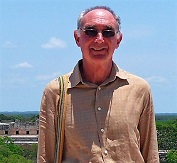


|
|
|
|||||||||||||||
|
|
||||||||||||||||
|
|
|||
|
|
Mexico
Together with Tikal and Chichen Itza, Uxmal most represents Maya Architecture at its best. The name is thought to mean “thrice built” although it has also been suggested that it derives from the word Uchmal, which refers to the future.
Although a great deal of work has been carried out at Uxmal - and in fact is still being carried out – not a lot is known about the city. It is believed that it was founded around 500 AD and that most of its development occurred between 700 - 1000 AD when it became a thriving city and a religious centre with great ceremonial significance. The layout of the buildings suggests knowledge of astronomy by its planners. At its peak, Uxmal had a population of around 25,000 inhabitants. Around 1000 AD the city was invaded by the Toltecs and it started to decline, it was abandoned around 1200 AD. Covering around 150 acres the central area of Uxmal is reasonably well preserved due to the high quality of the buildings which are constructed of well-cut stones set in concrete. The ruins today provide a good impression of what the city would have looked like at its height. The first major building seen on a visit to the site is the Pyramid of the Magician, also called Pyramid of the Dwarf as legend states that it was built by a dwarf overnight using magic. A stepped pyramid with five levels it raises to a height of 27.6m. The design is unusual in that the profile of each layer is elliptical in shape and not the normal rectilinear plan found in Maya pyramids. It was a common practice in Mesoamerica to build new pyramids on top of older ones, but in Uxmal a new pyramid was built off centre slightly to the east of the older pyramid so that on the west side the temple on top of the old pyramid is preserved but has the newer temple above it. 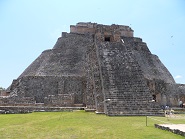 The temple at the top of the main staircase on the West face has a large mask with the mouth acting as the entrance. It has a number of masks at each corner. 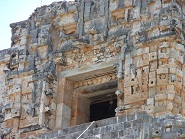 The East face has a wider staircase with a hole near its top; this was the result of excavations into the pyramid to study a temple that had been covered by the subsequent construction work.  The Maya would rebuild over existing buildings every 52-year cycle. Located at the side of the Pyramid of the Magician is the Quadrangle of the Nuns, named by the Spanish as it reminded them of a European nunnery. This consists of four buildings placed at different levels that surround a courtyard. Constructed sometime after 900 AD the façades are richly decorated with motives and latticework, masks, serpents, human figures, and representations of the gods, it is thought to have been used as a school for training healers, astrologers, shamans, and priests. Close by is the Quadrangle of the birds with the colonnade one of the buildings showing reconstructed columns. 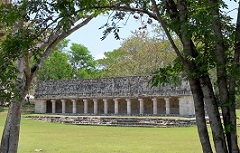 Walking through the site visitors will reach the Ball Court 33.5m long and 9.8m wide. 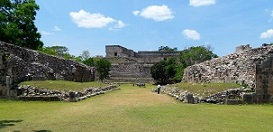 This is an excellent example and shows the court with its battered side and the location of the ring which was reconstructed in concrete from a remaining fragment. The Building of the Governor’s Palace is elevated on an artificial platform constructed on a levelled hill and covers over 5 acres. 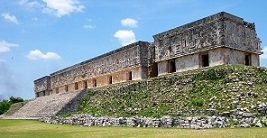 It was the last major structure completed at Uxmal. Its front façade is the largest Maya façade and its frieze consists of 15,000 mosaic pieces of carved stone running around the entire building. 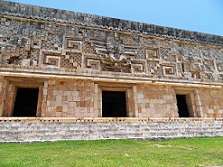 On the façades are vaulted passage-ways with plain inner surfaces, which break the otherwise continuous frieze. On the same platform next to the Palace is the House of the Turtles so named for the frieze of turtles carved around its cornice. In front of the Governor's Palace is a small shrine with a monolith in the form of an inverted cone that protrudes into the ground and a shrine with steps on 4 sides with a two-headed Jaguar Throne. 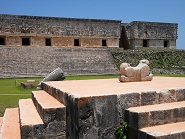 Looking down from the platform of the Governor’s Palace can be seen the Dovecote Roofcomb which has remained preserved over the centuries. To the side of the Palace is the Great Pyramid with its east side in a collapsed state and the north side - restored in the early 1970s - with its grand staircase leading to the Macaws Temple with its wide central doorway. 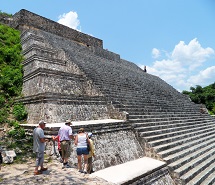 The Great Pyramid was originally nine levels high and has only been partially restored. Visitors are permitted to climb the pyramid which provides good views across the site. 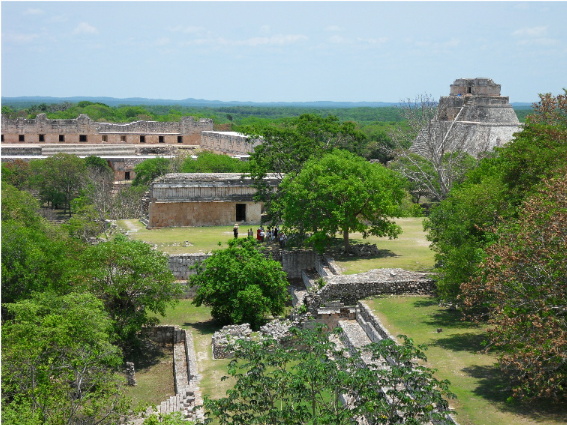 Throughout the site are a number of stone stelae with hieroglyphic inscriptions containing details of the city’s rulers, many of these stelae appear to have been deliberately damaged.  Another indication of conflict can be found in the remains of the wall that surrounded part of the site. Declared UNESCO World Heritage site in 1996 the site also contains a small museum to display some of the items found at the site. To see more photographs and take a virtual tour of the site click on the photoshow below Addition information can be seen on Encyclopaedia Britannica
|
|
|
|
|
|||
All Photographs were taken by and are copyright of Ron Gatepain
| Site Map |
